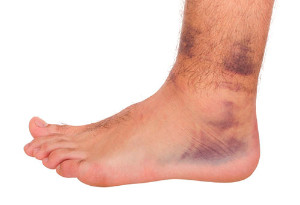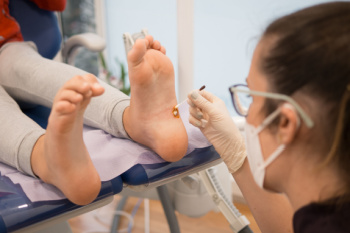
Despite its association with strength, the Achilles tendon is susceptible to injury which can lead to discomfort and impair mobility. Several factors contribute to the development of Achilles tendonitis, including wearing improper footwear, overexertion during activities like speed or mountain running, and insufficient recovery time between training sessions. Other causes can include incorrect loading of weight on the legs or feet, poor running technique, and a lack of proper warm-up exercises. These factors collectively strain this strong tendon, leading to micro-tears in its structure. If left untreated, Achilles tendonitis can progress through various stages of severity. Initially, Achilles tendonitis may cause discomfort during activity or mild pain, which diminishes with rest and conservative measures. However, as the condition progresses, symptoms worsen, with visible changes in the tendon's structure and increased pain levels. Scar tissue formation and a loss of full functionality characterize the advanced stage of this injury. If you are experiencing Achilles tendon pain, it is suggested that you schedule an appointment with a podiatrist for an exam, diagnosis, and treatment options.
Achilles tendon injuries need immediate attention to avoid future complications. If you have any concerns, contact Bruce Smit, DPM of Frankfort Foot & Ankle Clinic. Our doctor can provide the care you need to keep you pain-free and on your feet.
What Is the Achilles Tendon?
The Achilles tendon is a tendon that connects the lower leg muscles and calf to the heel of the foot. It is the strongest tendon in the human body and is essential for making movement possible. Because this tendon is such an integral part of the body, any injuries to it can create immense difficulties and should immediately be presented to a doctor.
What Are the Symptoms of an Achilles Tendon Injury?
There are various types of injuries that can affect the Achilles tendon. The two most common injuries are Achilles tendinitis and ruptures of the tendon.
Achilles Tendinitis Symptoms
Rupture Symptoms
Treatment and Prevention
Achilles tendon injuries are diagnosed by a thorough physical evaluation, which can include an MRI. Treatment involves rest, physical therapy, and in some cases, surgery. However, various preventative measures can be taken to avoid these injuries, such as:
If you have any questions please feel free to contact our office located in Frankfort, IL . We offer the newest diagnostic tools and technology to treat your foot and ankle needs.

Deciphering between an ankle sprain and a strain is sometimes difficult, as both injuries share common symptoms but necessitate distinct treatment approaches. An ankle sprain occurs when ligaments, resilient bands of tissue that connect bones, endure excessive stretching or tearing. Strains are the result of damage to the muscles or tendons that surround the ankle joint. Fractures typically induce excruciating pain, rendering weight-bearing nearly impossible, while sprains often permit limited mobility despite discomfort. Furthermore, the site of discomfort varies. Fractures elicit localized pain and potential deformity, while sprains cause more diffuse discomfort. Swelling and unusual sensations such as numbness or tingling are more prevalent in fractures, indicating the urgency of proper diagnosis. Consulting a podiatrist for thorough assessment via imaging techniques like X-rays or bone scans is paramount to formulate tailored treatment strategies promptly. Whether you have an ankle sprain, strain, or fracture, timely intervention is critical to avoid long-term complications. In case of any type of ankle injury, it is suggested that you schedule an appointment with a podiatrist for a diagnosis and treatment options.
Ankle pain can be caused by a number of problems and may be potentially serious. If you have ankle pain, consult with Bruce Smit, DPM from Frankfort Foot & Ankle Clinic. Our doctor will assess your condition and provide you with quality foot and ankle treatment.
Ankle pain is any condition that causes pain in the ankle. Due to the fact that the ankle consists of tendons, muscles, bones, and ligaments, ankle pain can come from a number of different conditions.
Causes
The most common causes of ankle pain include:
Symptoms
Symptoms of ankle injury vary based upon the condition. Pain may include general pain and discomfort, swelling, aching, redness, bruising, burning or stabbing sensations, and/or loss of sensation.
Diagnosis
Due to the wide variety of potential causes of ankle pain, podiatrists will utilize a number of different methods to properly diagnose ankle pain. This can include asking for personal and family medical histories and of any recent injuries. Further diagnosis may include sensation tests, a physical examination, and potentially x-rays or other imaging tests.
Treatment
Just as the range of causes varies widely, so do treatments. Some more common treatments are rest, ice packs, keeping pressure off the foot, orthotics and braces, medication for inflammation and pain, and surgery.
If you have any questions, please feel free to contact our office located in Frankfort, IL . We offer the newest diagnostic and treatment technologies for all your foot care needs.

Understanding the causes of foot pain in children is essential for parents. Common factors that may affect your child’s feet include wearing ill-fitting shoes without proper cushioning, which can lead to pain over time. Conditions like Achilles tendonitis, often observed in active children, result from repetitive strain on the Achilles tendon and can lead to swelling and pain. Fractures and injuries can cause acute pain and contribute to the development of bunions. Bursitis and corns or calluses, often caused by wearing poorly fitting shoes, can result in inflammation and thickened skin. Structural issues, such as flat feet, or postural defects may also contribute to childhood foot discomfort. Inflammatory conditions like juvenile arthritis can cause persistent foot pain. For appropriate treatment to address your child's foot pain, it is suggested that you schedule an appointment with a podiatrist who can conduct a full exam and offer an accurate diagnosis and effective treatment plan.
The health of a child’s feet is vital to their overall well-being. If you have any questions regarding foot health, contact Bruce Smit, DPM of Frankfort Foot & Ankle Clinic. Our doctor can provide the care you need to keep you pain-free and on your feet.
Tips for Keeping Children's Feet Healthy
If you have any questions, please feel free to contact our office located in Frankfort, IL . We offer the newest diagnostic and treatment technologies for all your foot care needs.

Plantar warts, also known as verrucas, can be painful and disruptive. These growths, caused by the human papillomavirus, or HPV, often appear as rough, grainy lesions on the weight-bearing areas of the foot, such as the ball and heel. Plantar warts develop when HPV infects the outer layer of skin on the foot, typically through cuts, cracks, or breaks in the skin. Certain factors, such as a weakened immune system or previous bouts of plantar warts, can increase susceptibility. Treatment options include prescription strength medications containing salicylic acid, cryotherapy, laser treatments, or surgical removal. Because it can be difficult to eradicate plantar warts on your own, a podiatrist can provide tailored treatment options to alleviate discomfort and minimize the risk of recurrence. If you have plantar warts, it is suggested that you schedule an appointment with a podiatrist for an exam and treatment options.
Plantar warts can be very uncomfortable. If you need your feet checked, contact Bruce Smit, DPM from Frankfort Foot & Ankle Clinic. Our doctor will assist you with all of your foot and ankle needs.
About Plantar Warts
Plantar warts are the result of HPV, or human papillomavirus, getting into open wounds on the feet. They are mostly found on the heels or balls of the feet.
While plantar warts are generally harmless, those experiencing excessive pain or those suffering from diabetes or a compromised immune system require immediate medical care. Plantar warts are easily diagnosed, usually through scraping off a bit of rough skin or by getting a biopsy.
Symptoms
Treatment
To help prevent developing plantar warts, avoid walking barefoot over abrasive surfaces that can cause cuts or wounds for HPV to get into. Avoiding direct contact with other warts, as well as not picking or rubbing existing warts, can help prevent the further spread of plantar warts. However, if you think you have developed plantar warts, speak to your podiatrist. He or she can diagnose the warts on your feet and recommend the appropriate treatment options.
If you have any questions please feel free to contact our office located in Frankfort, IL . We offer the newest diagnostic and treatment technologies for all your foot and ankle needs.

Preventing foot and ankle running injuries involves a varied approach encompassing various aspects of training and recovery. Strengthening the muscles, especially those in the feet and ankles, can help reduce injuries among runners. Regular strength training exercises, like lunges and squats done three to five times per week, can enhance muscular endurance, coordination, and balance, thereby supporting injury prevention efforts. Allowing adequate recovery time between training sessions is vital for muscle repair and adaptation. Aim for 36 to 48 hours of rest between runs, and gradually increase training volume to avoid overload caused by excessive training. It may not be possible to avoid running injuries, but implementing preventive measures can significantly reduce their likelihood and severity. If you incur a foot or ankle injury while running, it is suggested that you schedule an appointment with a podiatrist for an evaluation and treatment plan.
Exercising your feet regularly with the proper foot wear is a great way to prevent injuries. If you have any concerns about your feet, contact Bruce Smit, DPM of Frankfort Foot & Ankle Clinic. Our doctor will treat your foot and ankle needs.
How to Prevent Running Injuries
Many common running injuries are caused by overuse and overtraining. When the back of the kneecap starts wearing out and starts causing pain in your knee, this is commonly referred to as runner’s knee. Runner’s knee is a decrease in strength in your quadriceps and can occur if you’re not wearing properly fitted or supporting shoes. To prevent runner’s knee, focusing on hip strengthening is a good idea, as well as strengthening your quads to keep the kneecaps aligned.
What Are Some Causes of Running Injuries?
- One cause of a common running injury is called iliotibial band syndrome.
- Plantar fasciitis is also another common injury.
- Stress fractures can occur from overtraining, lack of calcium, or even your running style.
Best Ways to Prevent Running Injuries
- Wear footwear that fits properly and suits your running needs.
- Running shoes are the only protective gear that runners have to safeguard them from injury.
- Make a training schedule. Adding strengthening exercises as well as regular stretching can help keep you strong and limber and can lessen the possibility of injuries.
- Stretching keeps muscles limber; this will help you gain better flexibility.
If you have any questions please feel free to contact our office located in Frankfort, IL . We offer the newest diagnostic and treatment technologies for all your foot and ankle needs.